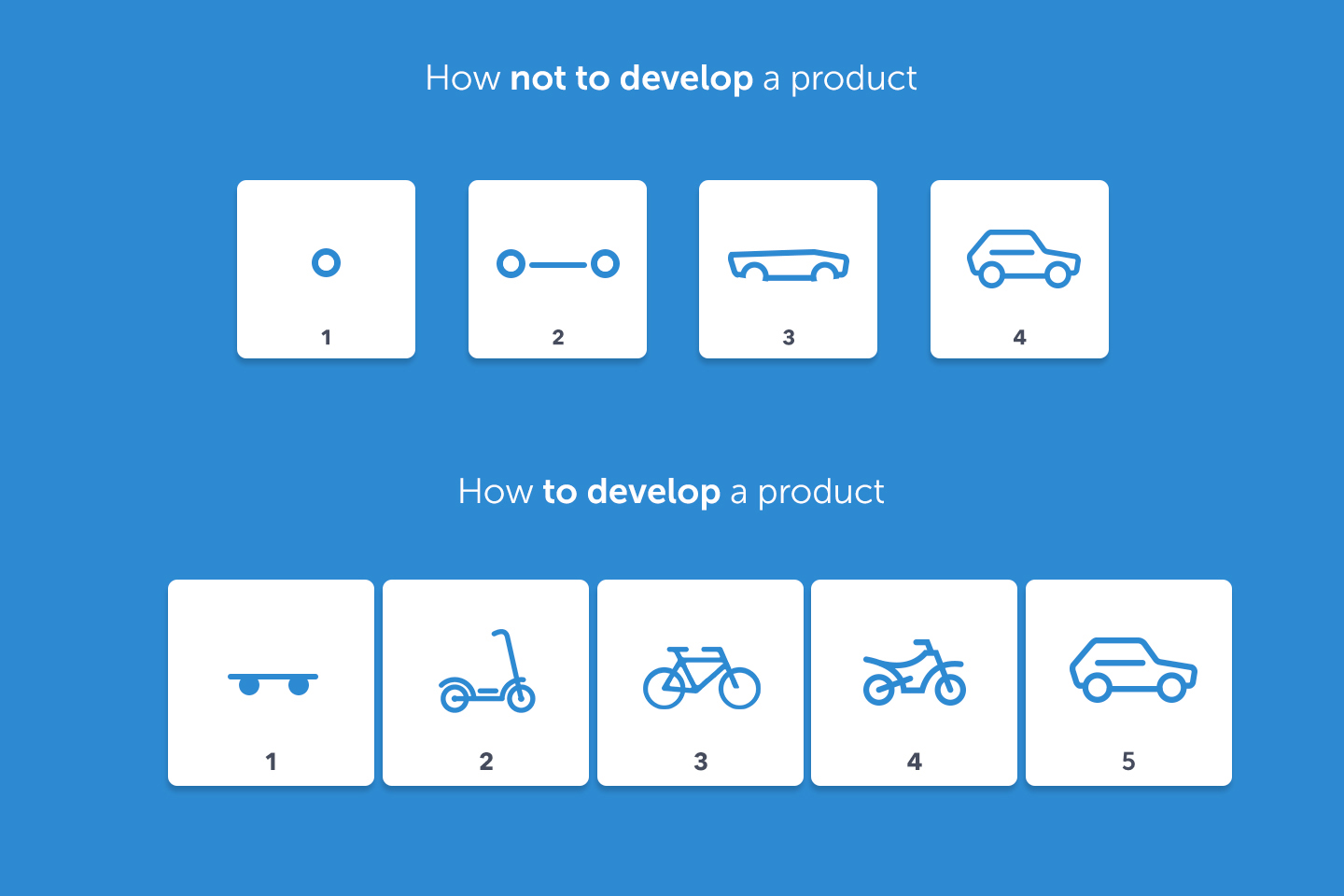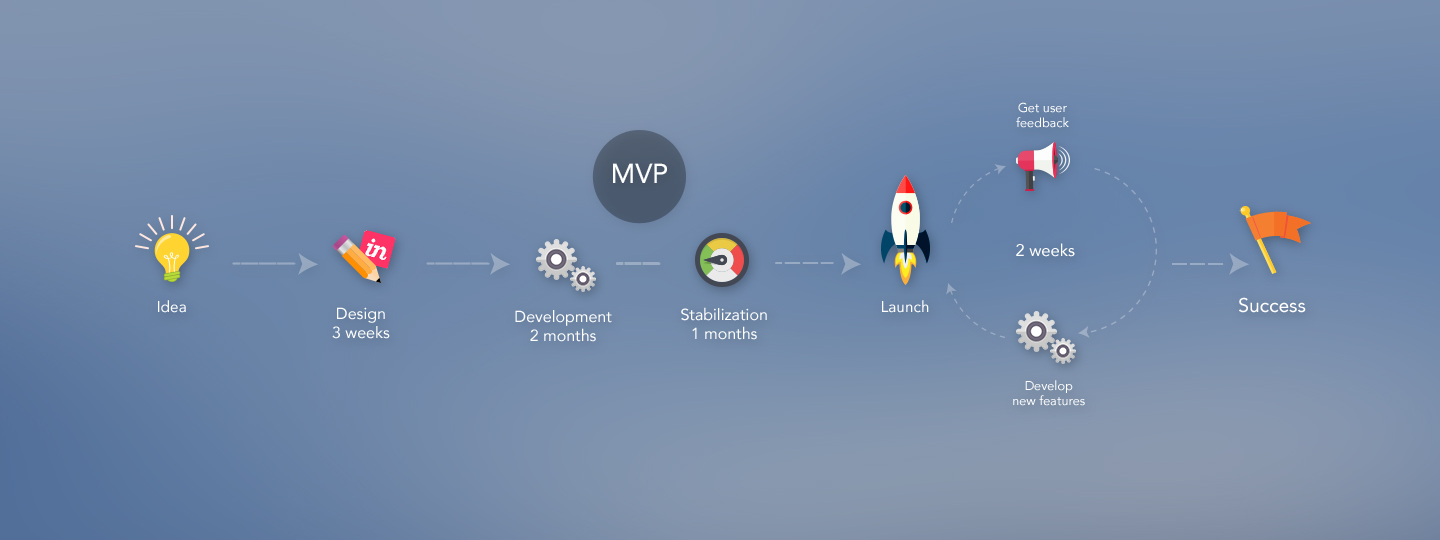Startup development using Lean Startup methodology

Although the definition of “startup” is becoming more and more popular nowadays, many people still have a vague idea of its meaning. There are a few definitions, but we’ll give you the one which is important for this topic as we don’t want to burden you with irrelevant information.
Eric Ries, author of the famous book “The Lean Startup”, defines startup as “an organization dedicated to creating something new under conditions of extreme uncertainty”.
Why under conditions of extreme uncertainty? The point is that a standard approach to startup development means too much is based on sheer assumptions (how the product will be working, which functionality it will have, the budget needed for the project etc.) that often fall short.
We should also note that startups are constantly changing during the development process. It’s their peculiarity and the reason why it is so difficult to write a detailed technical specification the whole development process.
Sure, you can write it, but it will suffer big changes due to many reasons: client’s new ideas, notes, requirements, constant changes and improvements during startup development etc.
Unfortunately, most startups fail because of a plenty of reasons, from a bad idea of the project and its low market value , to lack of investment (as money tends to end up at the right time).
However, one of the most frequent mistakes is the method of startup development. In “The Lean Startup”, Eric Ries writes: “Too many startup business plans look more like they are planning to launch a rocket ship than drive a car.
They prescribe the steps to take and the results to expect in excruciating detail, and as in planning to launch a rocket, they are set up in such a way that even tiny errors in assumptions can lead to catastrophic outcomes.”
It means that companies often try to develop everything at once, create application/product with the widest and most complex functionality, and this approach is rarely successful.
Look at the image above: it clearly shows how you shouldn’t develop a product. The idea is that when you want to make a car at once, you start with its parts trying to do everything right (and it’s not easy) and combine them.
Often somewhere in the middle of this process you find out that the first part was built improperly and you must remake everything, or at some moment your money ends and it’s necessary to urgently seek investments. Anyway, it’s a time-taking and complicated process requiring considerable expenses.
Here comes Lean Startup methodology. Startup development using Lean Startup approach is the fastest creation of the first version of application based on a client’s idea, with its further improvement and extension.
Startup development process according to Lean Startup method works like the image shows (how to develop a product). Based on the idea, a minimum viable product (MVP) is developed (on the image you see a scooter), and this is one of the main ideas of Lean Startup methodology.
It allows to see results and move forward, receiving feedback from users (their wishes, comments), adding new functions and expanding the app possibilities. And so it goes until we “find our ideal” – develop the best possible product.
This method completely solves a problem of startup development as it allows to begin with the smaller and step by step move to the bigger instead of trying to do all immediately, not paying attention to high costs and process complexity.
Receiving constant feedback from users, we create an ideal product for them, and, what’s more, quickly and at a reasonable price, which is a big advantage for clients.
Startup development using Lean Startup method has the following stages:
– idea, analysis of client’s requirements;
– design;
– preparation and approval of Backlog;
– development of the first version of product;
– stabilization;
– launch.
Let’s consider app/startup development stages on the example of our company.
The process starts when a client comes to us with their idea. First of all, we discuss it, collect and analyze the customer’s requirements.
At this stage we define principal tasks of the project, create and discuss its concept, choose the best app type for the project (we wrote how to do it in one of our previous posts).
After that, we develop design mock-ups in Invision ar sketches, as well as the future app architecture.
Then we work on the main functionality of the product: in a special document – Backlog (it refers to Agile methodology) – the main tasks and app functions are described.
After preparing tasks we forward them to our client who sets priorities, defining which functions are to be developed first (certainly, considering budget), – thus the sequence of app development process is defined. After creating Backlog we approve it with our client.
Having the tasks, we estimate the deadlines for their implementation and see which functions will be in the first version of the application (MVP). A small reminder: MVP is one of key ideas of Lean Startup methodology.
Generally, the development process takes two months as the main objective of Lean Startup approach is to launch the application as soon as possible, without testing it (with minimum possible functionality), – go ahead and do not stop!
Then we test and stabilize the first version of the project: find defects (bugs), remove them, improve the app, prepare it for release. This stage usually requires one month.
After the release we collect information about using the application from our users (what they do and don’t like, whether they have some comments and wishes) and analyze these data.
Based on this research, we “put the icing on our cake” by adding new functions, making different improvements, and stabilizing the app.
An important advantage of our work is the fact that we provide our clients with marketing support before the release as well as make configuration of tracking of the most important data for project results analytics.
Thus, our development process using Lean Startup methodology takes approximately four months (from two weeks to one month on requirements analysis, design, app architecture development, two months on application development, and one month for its testing and stabilization), and Lean Startup approach itself solves the problems of deadline of startup development, budget, and an ideal product creation, and this all is absolute advantage of this method, especially comparing it to the standard approach to startup development.
You can find Eric Ries’ book “The Lean Startup”, in which he shares his experience, both good and bad, including examples of developing startups, describes a standard approach, its problems, reasons for startups failures, analyses Lean Startup methodology, here. Eric Ries also writes a popular blog Startup Lessons Learned, which contains a lot of interesting and useful things about startups.
